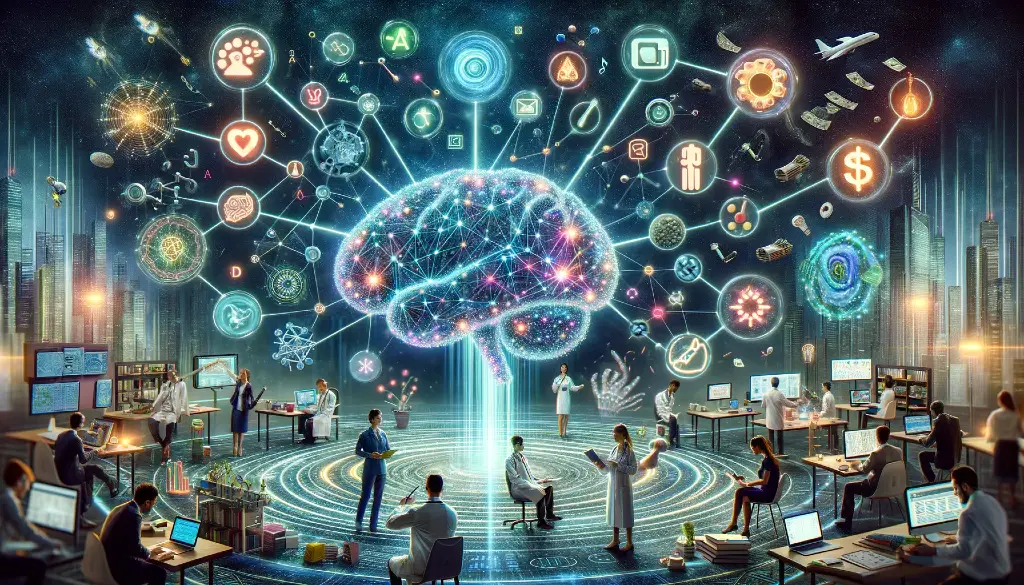Introduction
In the vast expanse of artificial intelligence (AI), a new era is dawning—one propelled by the remarkable rise of large language models(LLMs). Picture this: machines that can understand, generate, and interact with human language at an unprecedented scale and sophistication.
From answering complex questions to composing eloquent prose, these models are transforming the way we perceive AI and its potential. Welcome to “The Rise of Large Language Models: Transforming AI and Beyond,” where we embark on a journey through the intricacies of this groundbreaking technology and its profound implications for the future.
Prepare to be captivated, as we unravel the mysteries of large language models and explore the vast possibilities they hold for reshaping the landscape of AI and beyond.
Understanding Large Language Models
At the heart of the AI revolution lies the remarkable innovation of large language models, representing a paradigm shift in natural language processing (NLP). These models, such as OpenAI’s GPT series, are not merely tools for processing text but rather sophisticated neural networks trained on vast amounts of textual data. The essence of their power lies in their ability to understand context, semantics, and syntactic structures inherent in human language.
Large language models(LLMs) excel at a myriad of NLP tasks, from language translation and sentiment analysis to text generation and summarization. They accomplish this by leveraging deep learning architectures, such as transformers, which enable them to capture intricate patterns and relationships within text data. What sets these models apart is their sheer scale—their capacity to process billions of parameters and learn from colossal datasets harvested from the vast expanse of the internet.
Moreover, large language models (LLMs) exhibit a remarkable capacity for generative tasks, capable of producing coherent and contextually relevant text that mirrors human language. This transformative capability has sparked a wave of innovation, with applications ranging from automated content generation and conversational agents to virtual assistants and creative writing tools.
As we delve deeper into the realm of large language models, it becomes clear that their potential is boundless. They represent not just a leap forward in AI technology but a gateway to a future where human-machine interaction is more intuitive, seamless, and personalized than ever before.


The Impact of Large Language Models(LLMs) on AI
The emergence of large language models(LLMs) has unleashed a wave of transformative impact across the field of artificial intelligence (AI). These models, with their unprecedented scale and capabilities, have revolutionized the way AI systems understand, process, and generate natural language. Here are some key ways in which large language models have influenced AI:
- Advancements in Natural Language Processing (NLP): Large language models have propelled significant advancements in NLP, enabling AI systems to comprehend and generate human-like text with remarkable accuracy and fluency. Tasks such as sentiment analysis, text summarization, and language translation have been revolutionized by the capabilities of these models.
- Breakthroughs in Conversational AI: Large language models have ushered in a new era of conversational AI, enabling chatbots and virtual assistants to engage in more natural and human-like conversations. With their ability to generate contextually relevant responses and understand nuanced queries, large language models have elevated the quality of interactions between humans and AI systems.
- Enhanced Information Retrieval and Understanding: By processing vast amounts of textual data, large language models have significantly improved information retrieval and understanding capabilities. They can analyze and extract insights from unstructured data sources such as websites, documents, and social media posts, empowering businesses and researchers to make more informed decisions.
- Acceleration of AI Development: Large language models serve as powerful tools for AI development, providing researchers and developers with pre-trained models that can be fine-tuned for specific tasks or domains. This accelerates the development process, allowing for rapid prototyping and experimentation in various AI applications.
- Expansion of Creative Applications: The generative capabilities of large language models have unlocked new possibilities in creative applications, such as content generation, storytelling, and artistic expression. These models can compose poetry, generate music, and even create interactive narratives, blurring the lines between human and machine creativity.
Overall, the impact of large language models on AI is profound and far-reaching, transforming the way we interact with technology and opening doors to new realms of possibility. As these models continue to evolve and improve, their influence on AI research, development, and applications will only grow stronger, shaping the future of technology and human-machine interaction.
The Future of Large Language Models (LLMs)
As we peer into the horizon of AI innovation, the future of large language models appears bright and promising. These transformative technologies are poised to shape the next frontier of human-machine interaction and redefine the way we perceive and interact with artificial intelligence. Here are some key trends and developments that signal the future trajectory of large language models:
- Continued Scaling and Advancements: The trend of scaling up large language models is expected to continue, with researchers exploring ways to train even larger models with billions or even trillions of parameters. This will enable models to capture more nuanced linguistic patterns and context, leading to further improvements in performance and accuracy.
- Multi-Modal Capabilities: Future iterations of large language models are likely to incorporate multi-modal capabilities, allowing them to process and generate text alongside other modalities such as images, audio, and video. This will enable more immersive and interactive AI experiences, expanding the scope of applications in areas such as multimedia content generation and virtual environments.
- Zero-Shot Learning and Few-Shot Learning: Researchers are actively exploring techniques such as zero-shot learning and few-shot learning, which enable large language models to generalize to new tasks or domains with minimal or no additional training data. This will enhance the adaptability and versatility of these models, making them more applicable to a wide range of real-world scenarios.
- Improved Efficiency and Sustainability: Efforts are underway to improve the efficiency and sustainability of large language models, reducing their computational and energy requirements while maintaining or even enhancing performance. This includes research into more efficient training algorithms, model compression techniques, and hardware optimizations, paving the way for more environmentally friendly AI systems.
- Ethical and Societal Considerations: As large language models become more pervasive in our daily lives, there is growing awareness of the ethical and societal implications of their use. Future developments will likely focus on addressing issues such as bias, fairness, privacy, and transparency, ensuring that these technologies are deployed responsibly and equitably.
The future of large language models is one of innovation, progress, and transformative impact. As researchers and developers continue to push the boundaries of AI technology, these models will play an increasingly central role in shaping the way we communicate, create, and interact with intelligent systems.
Ethical Considerations and Challenges
As large language models continue to evolve and permeate various aspects of our lives, it is imperative to address the ethical considerations and challenges that accompany their widespread adoption. Here are some key considerations:
- Bias and Fairness: Large language models are trained on vast amounts of data collected from the internet, which may inadvertently reflect biases present in society. This can lead to biased outputs, perpetuating stereotypes and discrimination. It is essential to address bias in training data and develop algorithms that mitigate bias to ensure fairness and equity in AI applications.
- Privacy Concerns: Large language models have the potential to process and generate sensitive information, raising concerns about privacy and data security. There is a need for robust privacy-preserving techniques and regulations to safeguard individuals’ privacy rights and prevent unauthorized access or misuse of personal data.
- Misuse and Manipulation: The generative capabilities of large language models can be exploited for malicious purposes, such as generating fake news, spreading disinformation, or impersonating individuals. It is crucial to develop mechanisms for detecting and mitigating the misuse of AI-generated content and ensuring the authenticity and integrity of information online.
- Transparency and Accountability: Large language models operate as black-box systems, making it challenging to interpret their decision-making processes and hold them accountable for their actions. There is a need for greater transparency and explainability in AI algorithms to enhance trust and accountability, allowing users to understand how decisions are made and challenge biased or unfair outcomes.
- Environmental Impact: Training large language models requires significant computational resources, leading to high energy consumption and carbon emissions. It is essential to develop energy-efficient training algorithms, optimize hardware infrastructure, and explore alternative approaches to reduce the environmental footprint of AI systems.
Addressing these ethical considerations and challenges requires collaboration and concerted efforts from stakeholders across academia, industry, government, and civil society. By adopting ethical AI principles, promoting transparency and accountability, and prioritizing the well-being and rights of individuals, we can harness the transformative potential of large language models while mitigating their risks and ensuring that AI technology serves the greater good.
Conclusion
In conclusion, the rise of large language models represents a monumental leap forward in artificial intelligence, with profound implications for the future of technology and society. These transformative models have revolutionized natural language processing, enabling machines to understand, generate, and interact with human language in ways previously unimaginable. From advancements in conversational AI to breakthroughs in information retrieval and understanding, the impact of large language models is undeniable.
However, as we embrace the possibilities of this groundbreaking technology, it is essential to navigate the ethical considerations and challenges that accompany its deployment. By addressing issues such as bias, privacy, transparency, and environmental sustainability, we can ensure that large language models are developed and utilized responsibly, benefiting society while minimizing potential risks and harms.
At Verdict, we are committed to fostering responsible AI development and leveraging the power of large language models to create a future that is smarter, more connected, and more inclusive for all. Through our platform, we strive to promote transparency, accountability, and ethical practices in AI research and deployment, empowering users to harness the full potential of AI technology while upholding the highest standards of integrity and fairness.
As we continue to explore the possibilities of large language models and their impact on AI and beyond, let us remain vigilant in our pursuit of ethical innovation and responsible stewardship of AI technology. Together, we can shape a future where AI serves as a force for good, enriching our lives and driving positive change in the world. Join us on this journey of discovery and transformation, as we unlock the full potential of large language models and chart a course towards a brighter tomorrow.










